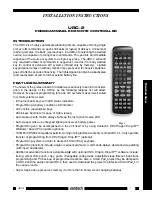
Motus Reference Manual
Page 39 of 146
Version 1.1
29/11/2019
10.6
Magnetics
Motus contains magnetometers which it uses to measure the Earth's magnetic field in
order to determine its heading. The principle is the same as that of a compass. When
operating Motus with magnetic heading enabled, sources of magnetic interference can
degrade Motus’s solution if not compensated for. There are two types of magnetic
interference, these are static and dynamic.
Static magnetic interference is caused by steel and other magnetic materials mounted
in the vehicle. Static disturbances are easily compensated for by running a magnetic
calibration, see section 11.5. A magnetic calibration should always be run after
installation into a vehicle.
Dynamic magnetic interference is generally a much bigger issue. Sources of dynamic
magnetic interference include high current wiring, electric motors, servos, solenoids
and large masses of steel that don't move with Motus. Motus should be mounted as far
as possible from these interference sources.
Motus contains a special algorithm to remove the effects of dynamic magnetic
interference. This is able to compensate for most typical interference sources
encountered, however certain types of prolonged dynamic interference cannot be
compensated for. The best way to check for dynamic magnetic interference is to use
the raw sensors view in Motus Manager and watch the magnetometer outputs whilst
the vehicle is operating but stationary, see section 12.7.4. The values should be
constant, if the values are fluctuating there is dynamic magnetic interference present.
If dynamic magnetic interference is causing performance problems and there is no
way to mount Motus away from the interference source, the magnetometers should be
disabled, see section 11.5.4.
10.7
Vibration
Motus is able to tolerate a high level of vibration compared to other inertial systems.
There is however a limit to the amount of vibration that Motus can tolerate and large
levels of vibration will cause Motus's accuracy to degrade.
When mounting Motus to a platform with vibration there are several options. It is
recommended to first try mounting Motus and see whether it can tolerate the
vibrations. The raw sensor view in the Motus Manager software can give you a good
idea of how bad the vibrations are. If the vibrations are causing the sensors to go over
range you will need to take preventative steps against the vibration.
If Motus is unable to tolerate the vibrations there are several options:
1. Try to find a mounting point with less vibration.
2. Motus can be mounted on top of a small flat piece of rubber. Please note that
this may cause small changing orientation errors due to flexing of the rubber.
3. Motus can be mounted to a plate which is then mounted to the platform through
vibration isolation mounts.
















































